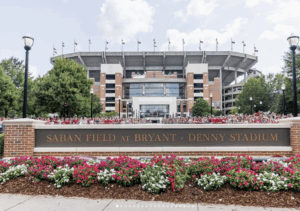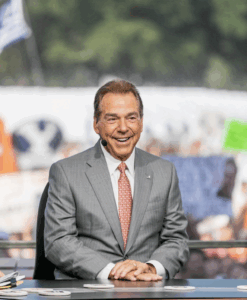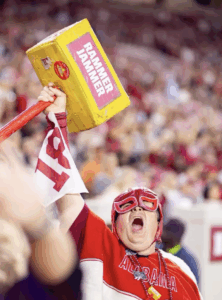The Art of Brand Loyalty: How Alabama Fans Turn Sponsorships into Social Capital
Published on October 29, 2025, at 11:58 a.m.
by Lucy Hall
In college football where team loyalty can run deep, The University of Alabama’s fandom is in a league of its own. Crimson Tide football fans serve as a measurable case study in how emotional engagement, ritual and brand alignment can generate business results.
Research has found that the Alabama football fanbase not only cheers for the Crimson Tide—they also support the companies that sponsor the team. From fast-food chains to sports apparel companies, any brand that publicly aligns with the Crimson Tide’s winning tradition becomes a part of the fan’s emotional landscape. This creates a unique marketing dynamic where sponsorships are not about the logo placement, but instead about the brand identity reinforcement.
The Importance of Rituals

On fall Saturdays in Tuscaloosa, Bryant-Denny Stadium becomes more than a football venue. While over 100,000 fans pour into the stadium, they represent a campus-wide phenomenon centered around traditions, competition and community. But what many brands have learned—and what PR professionals should take note of—is that the emotional value of these rituals extends far beyond kickoff.
Psychology Today reports the science behind a fanbase’s connection to their team. Lynn Zubernis Ph.D. found that fans with an emotional connection resonate better with their team’s fellow fanbase because they gain a feeling of community. According to her analysis, “being part of a fandom…satisfies belongingness [by providing] a community of like-minded people” and creates a sense of shared identity.
For The University of Alabama, that shared identity is rooted in traditions. Whether a fan is singing along to Dixieland Delightin the 4th quarter, participating in the ritual economy from home (purchasing from brands who sponsor the Crimson Tide on gameday) or engaging with superfans on campus, this identity is a mutual support system linking the fanbase community together.
Over the years, there have been “superfans” for each generation of followers. In the 1980s and ‘90s, Troy Ferguson and Jerry Bogle were known as the Big Dogs, recognized for their trademark accessory—two rolls of toilet paper bound by a Tide detergent box—symbolzing Roll Tide Roll. In 2025, fans look for Nacho Alabamo and his rammer jammer hammer. The tradition of super fans has transformed into a platform full of fans who follow and repost in support.
What began as a spontaneous video transformed Alabamo into a superfan overnight. He noted, “A video of me meeting Coach Saban got over half a million views…it was addicting to watch [the notifications].” The evolution of social media within football fandom is proof that there is a market for using a fanbase as a successful branding tool.
Nick Saban’s Impact to the Program

Nick Saban, a celebrity to The University of Alabama’s fanbase, was a turning point for the college football team. Once compared to Doug Floutie and his “Floutie Effect,” Saban is responsible for consistent growth of the university. A fanbase that was once a regional fan loyalty has now transformed into a national network of Alabama football fans. According to Jackson Poe with the Crimson White, “the numbers point to increased enrollment data since Coach Saban took over the football program.” There is an increase of out-of-state students, leveling up to over 54% of the student body, which has resulted in Alabama football becoming one of the most followed teams in the college bracket.
According to The New York Times, Alabama leads all college football programs with a combined 4.2 million followers across its football social media platforms–including Instagram, Facebook and X. The closest competitor, Louisiana State University, trails with 3.4 million. Streaming statistics are similar: Alabama football was the most watched college team during the 2021-24 regular season games.
Sponsorship’s That Are an Asset in Constant Motion
A brand’s decision to invest in the Crimson Tide Football program as a sponsor, gives them a campaign opportunity each game,

but also is the gift that keeps on giving with the support of fans. The visibility of sponsors does not happen by chance; their amplified reach is a continuous byproduct from the fanbase that sells itself.
In 2022, Dr. Pepper partnered with Alabama quarterback Bryce Young for the company’s Fansville campaign. This collaboration bridged the gap between local loyalty and national visibility, positioning Young not only as a football star but as a symbol of how brand awareness can expand its reach across generations of the college football audience. Every weekend tailgate, every branded gameday meal and shared Roll Tide on social media serves as micro-content to team sponsors.
For Alabama fans, the partnership represented the success within their football community. When Jacks became the “Official Biscuit of the Crimson Tide” in 2025, the announcement wasn’t just a sponsorship—it was a story. Fans viewed it as another symbol of community pride. Emilee Smart with The Tuscaloosa News noted that the Alabama-based chain joined the growing roster of local and national companies that see Crimson Tide partnerships as a direct route to fan loyalty.
College football creates a new blueprint for brand identity rooted in community over commodity. Alabama’s sponsorship landscape shows that consumers don’t just want to buy products—they want to buy into meaning in an authentic way. They are the ones who make sure the Tide keeps rolling.




